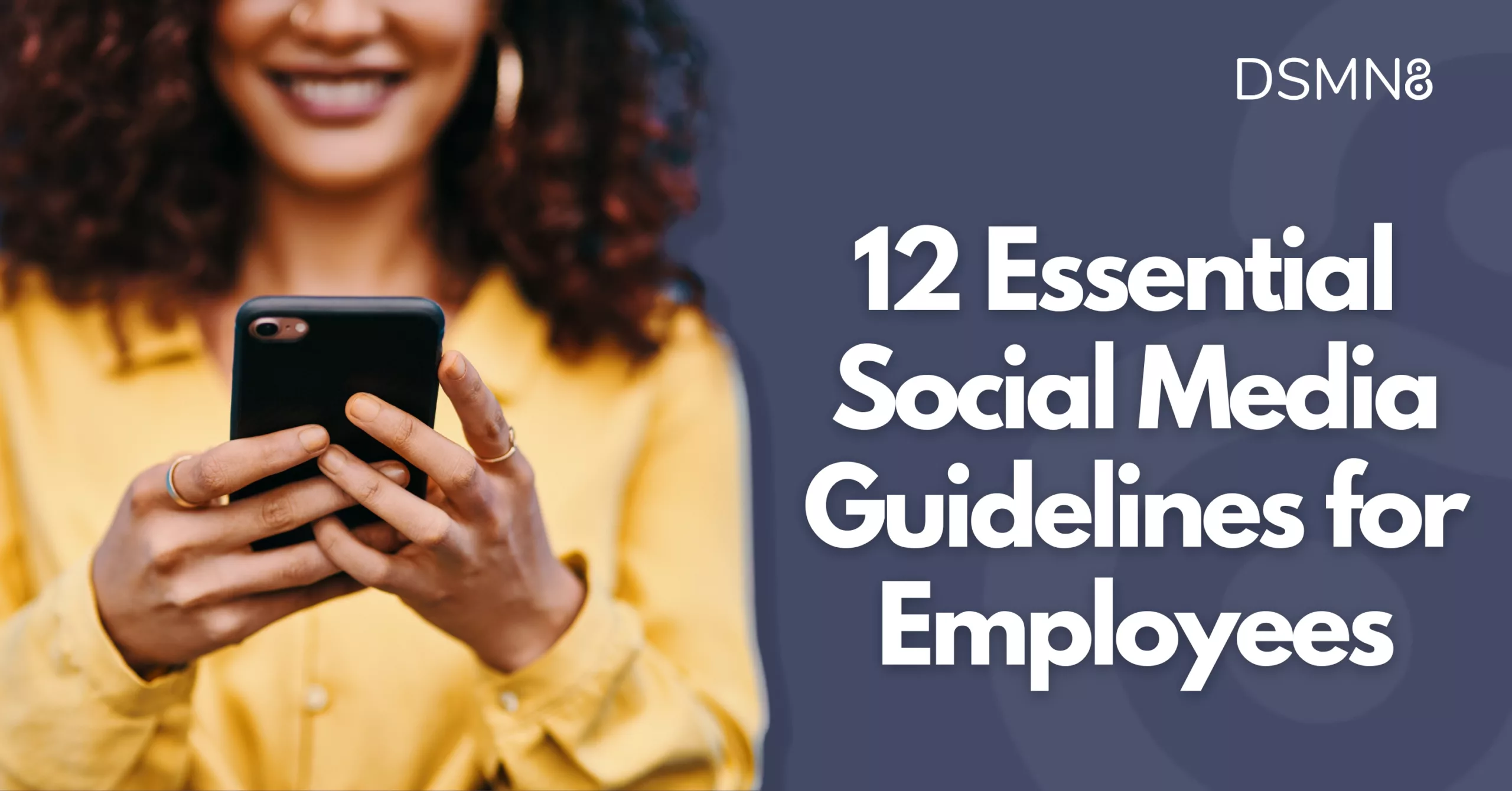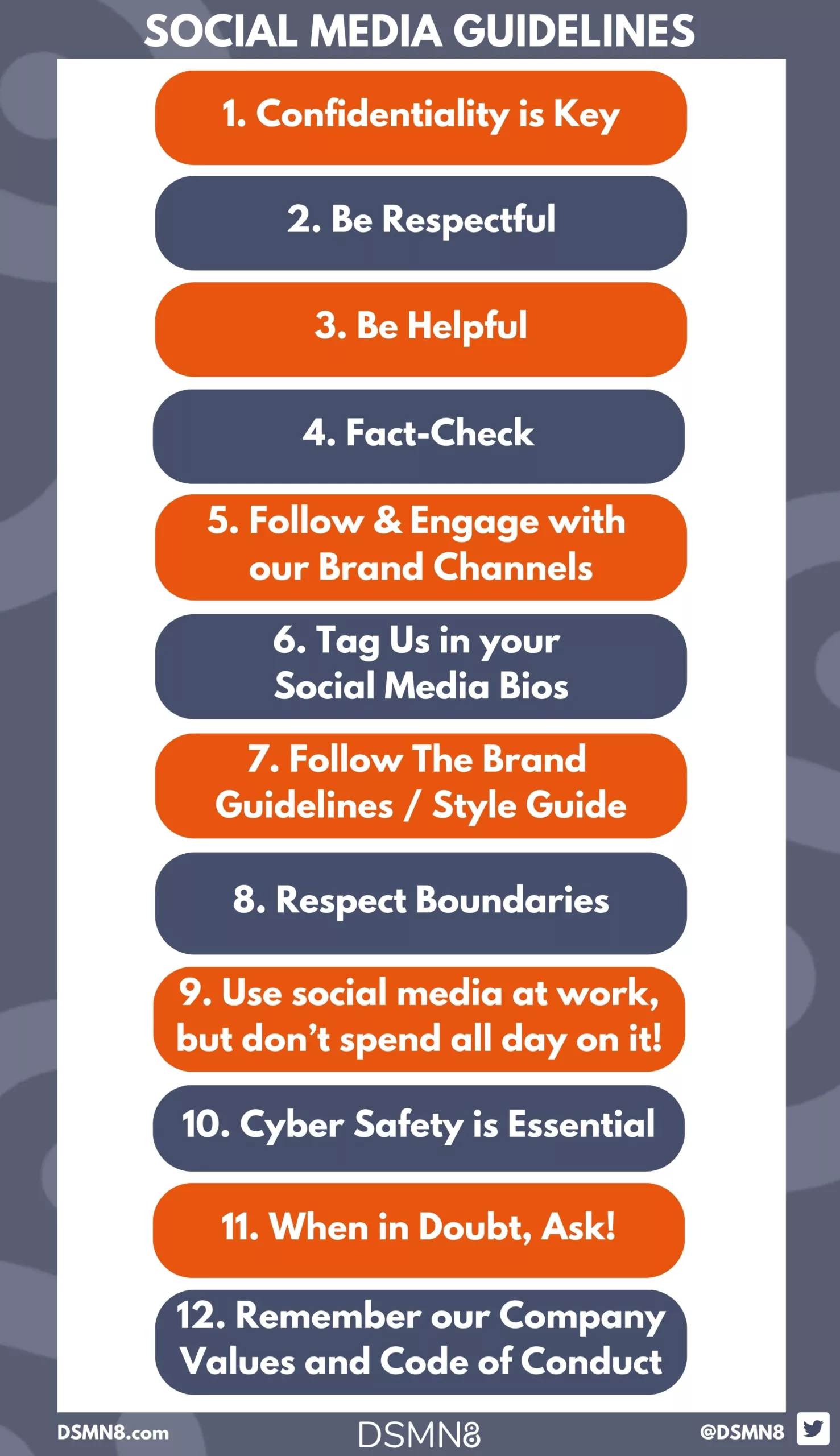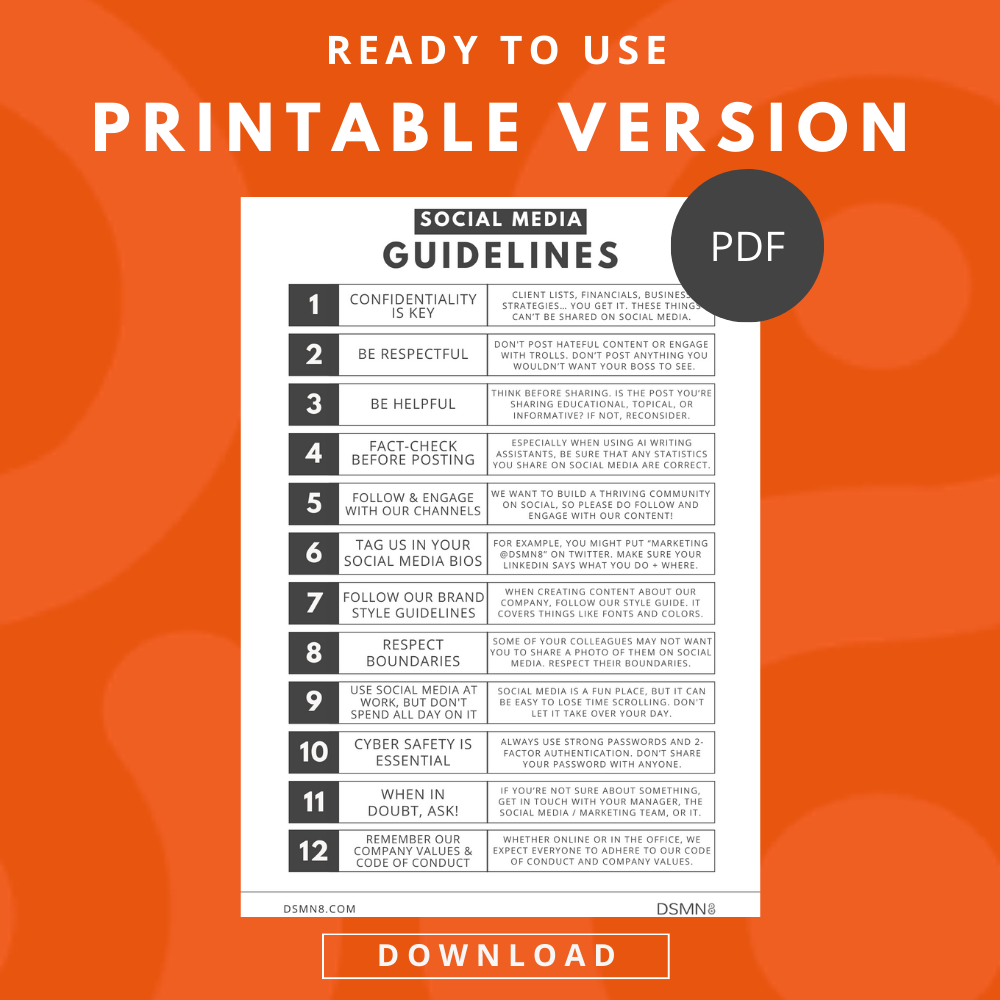
What's on this page:
- What’s the Difference between Social Media Guidelines and a Social Media Policy?
- Essential Employee Social Media Guidelines
- Examples of Social Media Guidelines from Big Brands
- Provide Resources & Training Alongside Your Guidelines
- Download The Template
- Additional Resources
- Podcast Episode on Creating a Great Social Media Policy
Over the past few years, attitudes towards employees using social media at work have changed dramatically.
Companies have gone from a “don’t post on social media” attitude, to “please do post on social media, and advocate for our brand”.
But, unfortunately, this change is often not communicated well, if at all.
Before asking employees to share content on social media, start with updating your social media policy, then develop social media guidelines.
Finally, make sure that all employees have access to these documents! Include them in your employee handbook, and new starter onboarding package.
Here are 12 essential employee social media guidelines, and why you should use them:
What's The Difference Between Social Media Guidelines and a Social Media Policy?
So what is the difference between a social media policy and social media guidelines?
There’s definitely some overlap, but they’re not exactly the same thing.
For most companies, a social media policy tends to be a more formal document, providing specific rules regarding social media.
For regulated industries, social media policies will include things like specific laws and regulations employees must adhere to. It often also includes consequences for breaking the policy.
The purpose is to mitigate the risks involved when it comes to employee activity on social media.
However, many companies have modernized their social media policies, to be less ‘scary’, and more encouraging.
It’s especially important to make your policy easy to understand. If yours needs a refresh, try our social media policy template!
On the other hand, social media guidelines are a way for companies to let employees know how they’d like them to act online, covering things like social media etiquette.
You can also use your guidelines to encourage things like tagging your company in their social media bios, and reminding them to check any photos taken at work before sharing them. It’s more general advice and best practices, rather than ‘rules’.
So why would you need both?
Well, if you’re in an industry like law, pharmaceuticals, or finance… You’re still going to need the ‘serious’ social media policy, for legal purposes, and to ensure compliance.
But that doesn’t mean your social media guidelines have to be 20 pages long.
Instead, make sure employees have access to your detailed policy, but also provide a shorter document that covers best practices for being professional on social media in the workplace.
12 Essential Employee Social Media Guidelines
So what should I include in my social media guidelines? 🤔
It will naturally vary from company to company, but below you will find the 12 essentials social media guidelines for employees. Plus you can grab a printable PDF version, ready to share with your team.

1. Confidentiality is Key.
Client lists, financial information, business strategies… you get it. These things can’t be shared on social media.
Be especially careful when taking photos at work. Check to see if anything confidential is in the background, e.g. on a whiteboard or on your computer screen.
2. Be Respectful.
Remember that you represent our company on social media. Don’t post anything hateful, or engage with trolls. Essentially, don’t post anything you wouldn’t want your boss to see.
3. Be Helpful.
Think before posting. Is the post you’re sharing educational, topical, or informative? If not, reconsider. There’s no point sharing content for the sake of it.
4. Fact-Check Before Posting.
Especially when using AI writing assistants, be sure that any statistics you share on social media are correct.
5. Follow & Engage with our Brand Channels.
We want to build a thriving community of employees on social, so please do follow and engage with our content! Support your colleagues’ content too.
6. Tag us in your Social Media Bios.
For example, you might put “Marketing Manager @DSMN8” on Twitter. Make sure that your LinkedIn profile says what you do and where you work.
7. Follow Our Brand Guidelines / Style Guide.
When creating content about our company, be sure to follow our brand style guide. This lets you know which fonts, colors, and assets to use. You can find it here: [link to your style guide].
8. Respect Boundaries.
Keep in mind that some of your colleagues might not want you to share a photo of them on social media. Respect their boundaries. The same goes with sending messages late at night – leave it until the next working day!
9. Use Social Media at Work, But Don’t Spend All Day On It.
Unless you’re a social media manager!
Social media is a fun place, but it can be easy to lose time scrolling. Consider blocking out a set time for managing your professional social channels each day. Don’t let it take over your day.
10. Cyber Safety is Essential.
Always use strong passwords and 2-factor authentication. It sounds obvious, but don’t share your password with anyone.
11. When in Doubt, Ask!
If you’re not sure about something, get in touch with your manager, the social media / marketing team, or IT. Don’t feel embarrassed. We’d always rather you question something than say nothing!
12. Remember our Company Values and Code of Conduct.
Whether online or in the office, we expect all employees to adhere to our code of conduct, and represent our company values.
Provide Resources & Training Alongside Your Guidelines
Providing employees with social media guidelines is a great place to start, but it doesn’t end there!
Remember that every employee has a different level of experience with social media, and different skillsets.
The best way to get everyone on the same page is to provide training, and resources. Take out the guesswork! Luckily, we’ve got an employee advocacy training plan for you to use.
If you really want to make the most out of having active employees on social media, this training should be ongoing. That way you’ll ensure that all new recruits understand that your company has a positive approach to social media, and how they can participate.
Your marketing team should be the first point-of-call for putting together things like brand guidelines, assets, and best practices for employees when talking about your company online. They could even create social media cover image templates, so employees have matching LinkedIn and Twitter headers!
But, I’m getting ahead of myself.
The very first thing you’ll need to do is create a space online for employees to find all of these assets, and of course, content to share. Images, social media posts, articles… There’s no use encouraging them to be active if they can’t find the resources they need.
Create a SharePoint or Google Drive folder, and make sure everyone knows where to find it. This should also be the place to house your social media policy, guidelines, and brand style guide.
Download The Printable PDF

Fill out the form below to get your employee social media guidelines in a printable PDF format. The document is A4 sized, in black & white, ready for printing and sharing with employees.
Additional Resources
We’ve created a bunch of resources and templates to help get your employees more active on social media.
Whether you’re just launching an employee advocacy program, or you’ve been managing one for a while, you’ll find something helpful in our Resource Hub and Templates Gallery.
Here are some top picks you’ll find helpful:
So, you’ve got your employees active on social media.
But what next? Wondering how to take it to the next level?
A fully-scaled employee advocacy program is the answer.
We can help with that! 👋
Podcast Episode on Creating a Great Social Media Policy 🎧
Emily Neal
SEO and Content Specialist at DSMN8. Emily has 10 years experience blogging, and is a pro at Pinterest Marketing, reaching 1 million monthly views. She’s all about empowering employees to grow their personal brands and become influencers.



